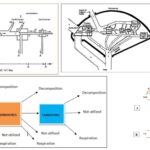Define the following terms: (a) aestivation (b) placentation (c) actinomorphic (d) zygomorphic (e) superior ovary (f) perigynous flower (g) epipetalous stamen
(a) Aestivation is the mode of arrangement of sepals or petals in floral buds with respect to the other members of the same whorl. (b) Placentation refers to the arrangement of ovules within the ovary. (c) Actinomorphic flowers are those which can be divided into two equal halves in any radial plane passing through the center, e.g., mustard. (d) Zygomorphic flowers can be divided into two similar halves only in one particular vertical plane, e.g., pea. (e) A superior ovary is one where the ovary is positioned above the other floral parts, e.g., mustard. (f) A perigynous flower has the ovary situated at the center and other floral parts are located on the rim of the thalamus at the same level, e.g., rose. (g) Epipetalous stamens are those where stamens are attached to the petals, as in brinjal.
Please login to submit an answer.
(a) Aestivation is the mode of arrangement of sepals or petals in floral buds with respect to the other members of the same whorl. (b) Placentation refers to the arrangement of ovules within the ovary. (c) Actinomorphic flowers are those which can be divided into two equal halves in any radial plane passing through the center, e.g., mustard. (d) Zygomorphic flowers can be divided into two similar halves only in one particular vertical plane, e.g., pea. (e) A superior ovary is one where the ovary is positioned above the other floral parts, e.g., mustard. (f) A perigynous flower has the ovary situated at the center and other floral parts are located on the rim of the thalamus at the same level, e.g., rose. (g) Epipetalous stamens are those where stamens are attached to the petals, as in brinjal.
- Share on Facebook
- Share on Twitter
- Share on LinkedIn
Helpful: 0%




